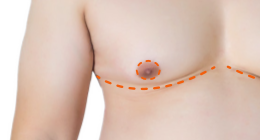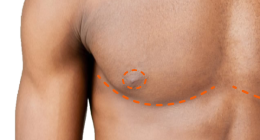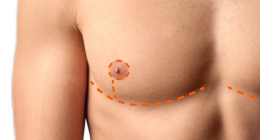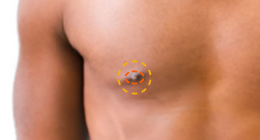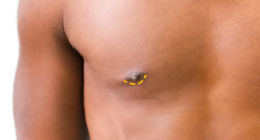Sponsored Article
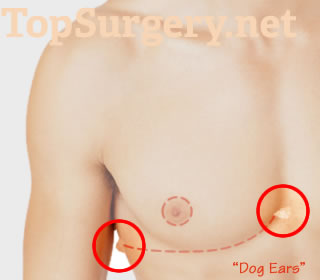 All About Top Surgery "Dog Ears"
All About Top Surgery "Dog Ears"
One of the important topics to research when planning for your Top Surgery is revisions. Not everyone needs a revision after Top Surgery, but it's a good idea to be prepared for the possibility. With Double Incision Top Surgery, one of the most common reasons for a revision is Dog Ears. Find out what Dog Ears really are and how to avoid them or get rid of them after Top Surgery in this one-stop primer featuring expert commentary from the popular Texas Top Surgery surgeon, Dr. Alan Dulin.
What Are Dog Ears?
"Dog Ears" is a term that refers to excess skin and fat that "pucker" out at the primary incision lines as they go around the sides of the chest in Double Incision Top Surgery. Dog Ears can also sometimes develop at the point where incisions come together near the center of the chest. Functionally, Dog Ears don't cause a problem but visually they can detract from otherwise excellent Top Surgery results.
Dog Ears are sometimes unavoidable. For example, in cases where multiple surgeries are required to remove excess skin, Dog Ears can be expected. Dog Ears usually require surgery to correct, but the revision can often be done without sedation.
How To Avoid Dog Ears?
Great Top Surgery outcomes are the result of a working partnership between the patient and the surgeon. When it comes to Dog Ears, both parties can contribute to reducing the likelihood of developing Dog Ears.
 According to Dr. Alan Dulin, a plastic surgeon who has performed Top Surgery in Texas for many years, Dog Ears are caused by excess skin and fat. While carrying extra weight doesn't automatically mean that you will get Dog Ears, staying close to your ideal body weight is one way that you can help avoid them.
According to Dr. Alan Dulin, a plastic surgeon who has performed Top Surgery in Texas for many years, Dog Ears are caused by excess skin and fat. While carrying extra weight doesn't automatically mean that you will get Dog Ears, staying close to your ideal body weight is one way that you can help avoid them.
Along with Dr. Dulin, there are a number of surgeons who have come up with techniques to prevent Dog Ears during the initial Top Surgery. Examples of these techniques include longer incisions that wrap further around the chest toward the back, and strategically employing liposuction at the sides of the chest, below the arm pit. When this extra contouring is performed, Dog Ears can be fairly consistently avoided.
 Dr. Hope Sherie, a popular Top Surgery surgeon in North Carolina considers Bra Roll Excision and liposuction to be useful tools when performing Top Surgery. "If someone has excess skin on the sides of the chest which makes a crease or bra roll, then I extend the incision to remove that skin and flatten the sides of the chest," says Dr. Sherie. "If there is also a fat layer on the sides of the chest or a fat pad under the arms which will be thicker than the front of the chest after breast removal, then I treat those areas with liposuction. By treating these areas of thicker fat and/or excess skin on the sides of the chest Dog Ears are avoided."
Dr. Hope Sherie, a popular Top Surgery surgeon in North Carolina considers Bra Roll Excision and liposuction to be useful tools when performing Top Surgery. "If someone has excess skin on the sides of the chest which makes a crease or bra roll, then I extend the incision to remove that skin and flatten the sides of the chest," says Dr. Sherie. "If there is also a fat layer on the sides of the chest or a fat pad under the arms which will be thicker than the front of the chest after breast removal, then I treat those areas with liposuction. By treating these areas of thicker fat and/or excess skin on the sides of the chest Dog Ears are avoided."
Regardless of the surgeon and technique though, Dog Ears can still develop after Top Surgery. Post-operative weight gain—as well as dramatic weight loss—can both cause Dog Ears, says Dr. Dulin.
How To Get Rid of Dog Ears?
Dog Ears can become obvious soon after surgery or may take several months to appear. Once Dog Ears have been confirmed, is there anything that can be done to get rid of them? Yes, says Dr. Dulin. Massaging Dog Ears can have some positive effect, especially if surgical swelling is present, and losing weight can also resolve Dog Ears.
If these solutions don't apply, a secondary revision surgery can easily take care of Dog Ears. The extra skin is excised and liposuction is used to remove any remaining excess fat. The revision can often be done using topical anesthesia versus general anesthesia, ensuring an easier recovery compared to the initial Top Surgery, as well as lower costs.
If there are other minor cosmetic concerns, the revision surgery presents a perfect opportunity to address these as well. It's best to wait about 6-9 months before doing a revision. This allows Top Surgery results to “settle,” and sometimes that's all that's needed to resolve minor cosmetic concerns.
Dog Ears are probably the most common reason for having a revision after Double Incision Top Surgery. While there are ways to avoid them, a revision surgery is often needed. If you're concerned about Dog Ears, talk with your prospective surgeon(s) about ways that you can work together to reduce the chances of Dog Ears developing.
Related: Top Surgery Revisions - Stats, Causes, Costs and Tips. Revisions can improve Top Surgery results dramatically and should be considered if you're not satisfied with your results. Find out what you need to know about getting a revision.
